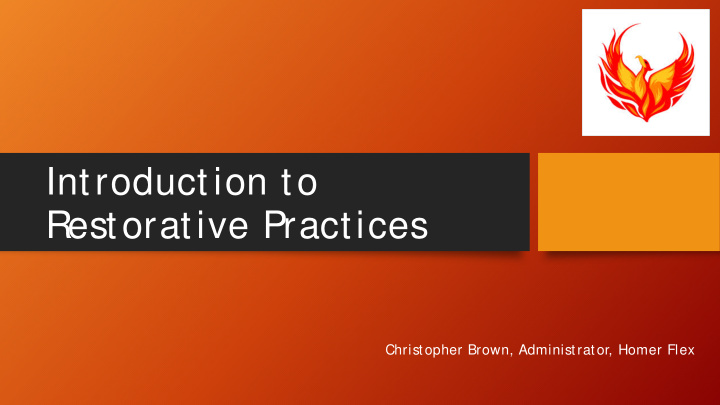



Introduction to Restorative Practices Christopher Brown, Administrator, Homer Flex
Overview of Presentation: • Introduction of restorative practices and how they can be used in schools. • Provide examples of restorative practices at Flex. • S how how restorative practices have succeeded in improving school climate. • Describe steps and process of implementation .
Providing Context Restorative Flex’s path to restorative practices Practices Goals: • Focus on S chool Climate • Improve Relationships Trauma • Reduce S uspensions PBIS Informed Schools
Restorative Practices Key Definition of Restorative Practices: Restorative Practices is a system of Relationship Based Principles principles and processes that build and sustain a culture of respect, responsibility and accountability. This is achieved through emphasizing the importance of trusting relationships as Repairing Relationships Building/ S ustaining and Restoring Trusting Relationships central to building community and Community repairing relationships when harm has occurred.
Key Principles of Restorative Practices 1.Acknowledge that relationships are central to building community. 2.Ensure equity of voice among all members of the community. All voices are valued, everyone is heard. 3.Establishes a culture of high expectations with high support emphasizing doing things “ with” not “ to” or “ for.” 4.Builds systems that address misbehavior and harm in a way that strengthens relationships and focuses on harm done rather than rule breaking. 5.Engages in collaborative problem solving. 6.Enhances accountability, responsibility, and empowers change and growth for all members of the community.
The Restorative Practices Handbook: “ The underlying premise of restorative practices is that people are happier, more cooperative, more productive and more likely to make positive changes when those in positions of authority do things with them rather than to them or for them.”
“ Y ou need t o see t he f ullness of who a person is, Removing S hame and S tigma if you are looking f or j ust ice.” -Christina S warns, NAACP Braithwaite’s Hypothesis: S eparating “ the deed from the doer” Restorative Practices allow: The act (unacceptable behavior) to be rej ected because they failed to meet expectations or standards While: Acknowledging the intrinsic worth of the person and their potential contribution to society
Restorative Practices Continuum https:/ / www.youtube.com/ watch? v=7Zk6oRMyj 4c
Restorative Questions • What happened, and what were you thinking at the time of the incident? • What have you thought about since? • Who has been affected by what happened and how? • What about this has been the hardest for you? • What do you think needs to be done to make things as right as possible?
Community Building Circles "Y ou can't rest ore j ust ice t o t he communit y when you haven't creat ed a communit y t o begin wit h." A structured process for bringing people together to: – Understand one another – S trengthen bonds – S hare & understand feelings
Affective S tatements and Restorative Conversations “ The most basic and • Observation powerful way t o • Feeling connect t o anot her person is t o list en. • Need Just list en. Perhaps t he most import ant • Request t hing we ever give each ot her is our at t ent ion.” -Rachel Naomi Remen, M.D.
Restorative Interventions, Restorative Circles, and Formal Conferences • What happened, and what were you thinking at the time of the incident? • What have you thought about since? • Who has been affected by what happened and how? • What about this has been the hardest for you? • What do you think needs to be done to make things as right as possible?
Positive outcomes of restorative practices • Improvements in attitudes and relationships across the whole school community. • An increase in engagement and learning of students in the classroom. • Growth in relational problem-solving skills. • A calmer school environment. • Decrease in out of school suspensions. • Decrease in tardies and absences.
Resources • S tate of Alaska’s Trauma Informed S chools Framework • International Institute of Restorative Practices (IIRP) • Kerri Berkowitz, Restorative Practices Consultant • Ingrid Harrald, Districtwide S EL Counselor
Recommend
More recommend